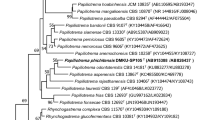Abstract
A new yeast species, Kazachstania wufongensis, is proposed in this paper based on six strains isolated from soil in Taiwan. The species may produce one to four ellipsoidal ascospores in each ascus, directly transformed from diploid cells. Genus assignment and distinction of the species from other recognized species of Kazachstania is based on morphological and physiological characteristics, and on phylogenetic analysis of nucleotide sequences of the D1/D2 domains of the large subunit (LSU) rRNA gene. Sequence analysis of the D1/D2 domains of the LSU rRNA gene reveals that K. wufongensis is a member of the Kazachstania exigua complex, and its phylogenetically closest relatives are K. exigua, K. barnettii, K. bulderi, and K. turicensis. The species can be further differentiated from the other phylogenetically related species based on internal transcribed spacer sequence and electrophoretic karyotype. Therefore, the new species Kazachstania wufongensis sp. nov. is proposed. The type strain of this new species, which was isolated from forest soil in Wufong, Hsinchu, Taiwan, is FN21S03T (=CBS 10886T = BCRC 23138T).



Similar content being viewed by others
References
Carle GF, Olson MV (1985) An electrophoretic karyotype for yeast. Proc Natl Acad Sci USA 82:3756–3760
Felsenstein J (1995) Confidence limits on phylogenies: an approach using the bootstrap. Evolution 39:783–791
Imanishi Y, Ueda-Nishimura K, Mikata K (2007) Two new species of Kazachstania that form ascospores connected by a belt-like intersporal body: Kazachstania zonata and Kazachstania gamospora. FEMS Yeast Res 7:330–338
Kumar S, Tamura K, Nei M (2004) MEGA3: integrated software for molecular evolutionary genetics analysis and sequence alignment. Brief Bioinform 5:150–163
Kurtzman CP (2003) Phylogenetic circumscription of Saccharomyces, Kluyveromyces and other members of the Saccharomycetaceae, and the proposal of the new genera Lachancea, Nakaseomyces, Naumovia, Vanderwaltozyma and Zygotorulaspora. FEMS Yeast Res 4:233–245
Kurtzman CP, Robnett CJ (1998) Identification and phylogeny of ascomycetous yeasts from analysis of nuclear large subunit (26S) ribosomal DNA partial sequences. Antonie Van Leeuwenhoek 73:331–371
Kurtzman CP, Robnett CJ (2003) Phylogenetic relationships among yeasts of the ‘Saccharomyces complex’ determined from multigene sequence analyses. FEMS Yeast Res 3:417–432
Kurtzman CP, Robnett CJ, Wart JM, Brayton C, Gorelick P, Walsh TJ (2005) Multigene phylogenetic analysis of pathogenic Candida species in the Kazachstania (Arxiozyma) telluris complex and description of their ascosporic states as Kazachstania bovina sp. nov., K. heterogenica sp. nov., K. pintolopesii sp. nov., and K. slooffiae sp. nov. J Clin Microbiol 43:101–111
Lachance MA (1998) Kluyveromyces van derWalt emend. van der Walt. In: Kurtzman CP, Fell JW (eds) The yeasts, a taxonomic study, 4th edn. Elsevier, Amsterdam, pp 227–247
Lee CF, Liu CH, Young SS, Chang KS (2008) Kazachstania jiainicus sp. nov., an ascomycetous yeast species isolated from soil in Taiwan. FEMS Yeast Res 8:114–118
Lee CF, Yao CH, Liu YR, Hsieh CW, Young SS (2009) Lachancea dasiensis sp. nov., an ascosporogenous yeast isolated from soil and leaves in Taiwan. Int J Syst Evol Microbiol (in press)
Limtong S, Yongmanitchai W, Tun MM, Kawasaki H, Seki T (2006) Kazachstania siamensis sp. nov., an ascomycetous yeast species from forest soil in Thailand. Int J Syst Evol Microbiol 57:419–422
Liu CH, Young SS, Chang TC, Lee CF (2008) C. dajiaensis sp. nov., C. yuanshanicus sp. nov., C. jianshihensis sp. nov., and C. sanyiensis sp. nov., four anamorphic, ascomycetous yeast species isolated from soil in Taiwan. FEMS Yeast Res 8:815–822
Lu HZ, Cai Y, Wu ZW, Jia JH, Bai FY (2004) Kazachstania aerobia sp. nov., an ascomycetous yeast species from aerobically deteriorating corn silage. Int J Syst Evol Microbiol 54:2431–2435
Middelhoven WJ, Kurtzman CP, Vaughan-Martini A (2000) Saccharomyces bulderi sp. nov., a yeast that ferments gluconolactone. Anton van Leeuwenhoek 77:223–228
Mikata K, Ueda-Nishimura K, Hisatomi T (2001) Three new species of Saccharomyces sensu lato van der Walt from Yaku Island in Japan: Saccharomyces naganishii sp. nov., Saccharomyces humaticus sp. nov. and Saccharomyces yakushimaensis sp. nov. Int J Syst Evol Microbiol 51:2189–2198
Nisiotou AA, Nychas GJ (2008) Kazachstania hellenica sp. nov., a novel ascomycetous yeast from a Botrytis-affected grape must fermentation. Int J Syst Evol Microbiol 58:1263–1267
Suzuki M, Nakase T (2002) A phylogenetic study of ubiquinone-7 species of the genus Candida based on SSU ribosomal DNA sequence divergence. J Gen Appl Microbiol 48:55–65
Thompson JD, Gibson TJ, Plewniak F, Jeanmougin F, Higgins DG (1997) The CLUSTAL_X windows interface: flexible strategies for multiple sequence alignment aided by quality analysis tools. Nucleic Acids Res 25:4876–4882
Vaughan-Martini A, Martini A (1998) Saccharomyces Meyen ex Reess. In: Kurtzman CP, Fell JW (eds) The yeasts, a taxonomic study, 4th edn. Elsevier, Amsterdam, pp 358–371
White TJ, Bruns T, Lee S, Taylor J (1990) Amplification and direct sequencing of fungal ribosomal RNA genes for phylogenetics. In: Innis MA, Gelfand DH, Sninsky JJ, White TJ (eds) PCR protocols: a guide for methods and applications. Academic Press, New York, pp 315–322
Wu ZW, Bai FY (2005) Kazachstania aquatica sp. nov. and Kazachstania solicola sp. nov., novel ascomycetous yeast species. Int J Syst Evol Microbiol 55:2219–2224
Wyder M-T, Meile L, Teuber M (1999) Description of Saccharomyces turicensis sp. nov., a new species from kefyr. Syst Appl Microbiol 22:420–425
Yarrow D (1998) Methods for the isolation, maintenance and identification of yeasts. In: Kurtzman CP, Fell JW (eds) The yeasts, a taxonomic study, 4th edn. Elsevier, Amsterdam, pp 77–102
Acknowledgments
This work was supported by a Grant-in-Aid (NSC 95-2621-B-134-001) from the National Science Council, Executive Yuan, Taiwan.
Author information
Authors and Affiliations
Corresponding author
Rights and permissions
About this article
Cite this article
Lee, CF., Yao, CH., Liu, YR. et al. Kazachstania wufongensis sp. nov., an ascosporogenous yeast isolated from soil in Taiwan. Antonie van Leeuwenhoek 95, 335–341 (2009). https://doi.org/10.1007/s10482-009-9319-6
Received:
Accepted:
Published:
Issue Date:
DOI: https://doi.org/10.1007/s10482-009-9319-6




